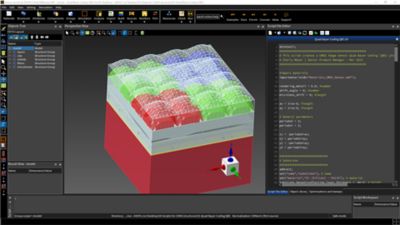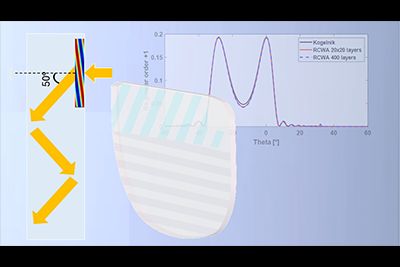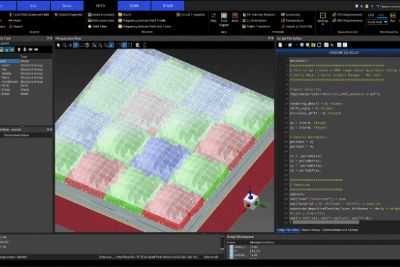기본 사양
Ansys Lumerical FDTD는 Ansys Lumerical CML Compiler, Ansys 다중물리 솔버, Ansys Speos, Ansys Zemax 및 타사 EPDA(전자 광자 설계 자동화) 공급업체와 원활하게 작동하여 빠르고 정확하며 확장 가능한 포토닉 설계를 지원합니다.
Ansys Lumerical FDTD는 단일 설계 환경에서 FDTD, RCWA 및 STACK 솔버를 통합한 포토닉 시뮬레이션 소프트웨어입니다. 이를 통해 회절 격자, 다층 코팅, uLED, CMOS 이미지 센서, 금속 렌즈 및 메타표면을 포함한 다양한 장치에 대한 정밀한 분석 및 최적화가 가능해져 다양한 응용 분야에서 동급 최고의 성능을 제공합니다. Ansys Lumerical FDTD는 가장 복잡한 설계에 대해 신속한 가상 프로토타입 제작과 수천 번의 반복 검증을 지원합니다.

Ansys Lumerical FDTD는 Ansys Lumerical CML Compiler, Ansys 다중물리 솔버, Ansys Speos, Ansys Zemax 및 타사 EPDA(전자 광자 설계 자동화) 공급업체와 원활하게 작동하여 빠르고 정확하며 확장 가능한 포토닉 설계를 지원합니다.
2025년 1월
2025 R1에서의 개선으로 더 빠른 메싱 및 더 광범위한 시스템 모델링을 위한 Ansys Lumerical FDTD의 강력한 GPU 가속 시뮬레이션, AR/VR의 홀로그램 격자 설계를 위한 혁신적인 레이어 반복, 탁월한 효율성과 유용성을 위한 세련되고 간소화된 사용자 인터페이스를 통해 포토닉스 설계를 혁신합니다.

Ansys Lumerical FDTD의 최신 개선에는 GPU 가속 시뮬레이션이 도입되어 메모리를 크게 절약하고 메싱 시간을 단축할 수 있습니다. 이러한 발전을 통해 Photonics 엔지니어와 연구원들은 향상된 효율로 더 큰 시스템을 시뮬레이션할 수 있으므로 성능 저하 없이 더 복잡한 설계와 시스템을 쉽게 처리할 수 있습니다.

RCWA에서 볼륨 홀로그램 격자를 시뮬레이션하기 위한 새로운 레이어 반복 기능은 AR/VR 및 헤드업 디스플레이 애플리케이션을 위한 홀로그램 격자의 빠른 다층 시뮬레이션을 제공합니다.

Ansys Lumerical FDTD 사용자 인터페이스는 효율적인 작업 시작과 향상된 유용성을 위한 새로운 탭 툴 스트립을 갖춘 현대적이고 간소화된 설계를 특징으로 합니다.
기능
Lumerical FDTD는 광범위한 포토닉 구성 요소의 설계 및 최적화를 위한 업계 최고의 시뮬레이션 소프트웨어입니다. Lumerical FDTD는 범용성과 확장성이 뛰어나며 비교할 수 없는 속도와 HPC(CPU 및 다중 GPU) 및 클라우드 리소스를 활용하는 기능을 제공합니다.
Ansys는 모든 사용자가 당사 제품에 액세스할 수 있다는 것을 가장 중요하게 생각합니다. 따라서 US Access Board(508조), Web Content Accessibility Guidelines(WCAG) 및 Voluntary Product Accessibility Template(VPAT)의 현재 형식에 근거한 접근성 요구 사항을 준수하기 위해 노력하고 있습니다.
엔지니어링 과제에 직면하고 있다면우리 팀이 도와드리겠습니다. 풍부한 경험과 혁신에 대한 헌신을 가지고 있는 우리에게 연락해 주십시오. 협력을 통해 엔지니어링 문제를 성장과 성공의 기회로 바꾸십시오. 지금 문의하기